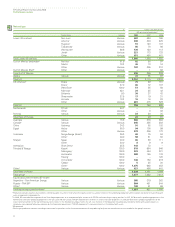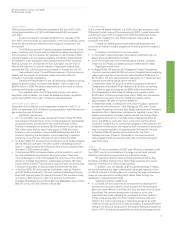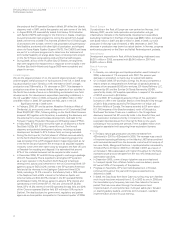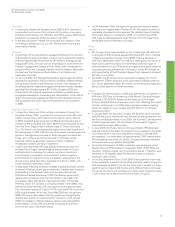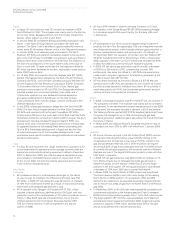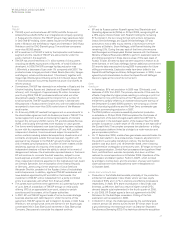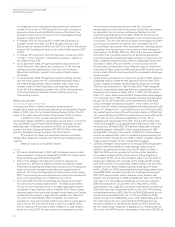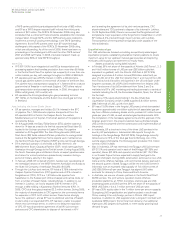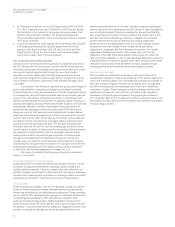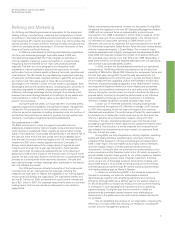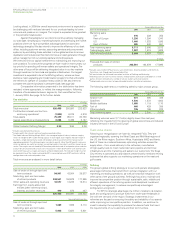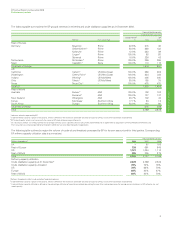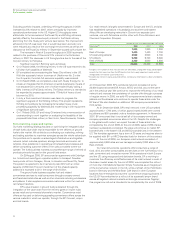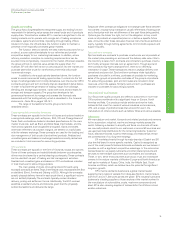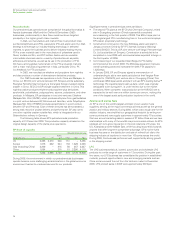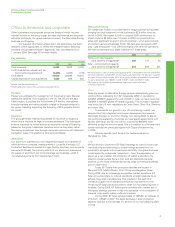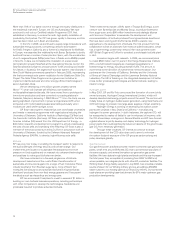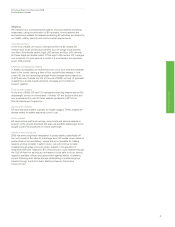BP 2008 Annual Report Download - page 30
Download and view the complete annual report
Please find page 30 of the 2008 BP annual report below. You can navigate through the pages in the report by either clicking on the pages listed below, or by using the keyword search tool below to find specific information within the annual report.
BP Annual Report and Accounts 2008
Performance review
a TAPS carrier paid third party shippers tariff refunds of $52 million;
and BP as a TAPS shipper received tariff refunds from third party
carriers of $27 million. The FERC’s 20 November 2008 ruling also
concluded that a unified tariff rate should be established for interstate
transportation through TAPS, and the TAPS carriers were ordered to
implement a revenue pooling methodology in the TAPS Operating
Agreement. Some TAPS carriers other than BP have filed legal
challenges to this aspect of the FERC’s 20 November 2008 ruling,
which are still pending. As of the end of 2008, there have been no
proceedings in the challenges to BP’s and the other TAPS carriers’
2007 and 2008 tariff rates. In 2008, interstate transport made up
approximately 86% of total TAPS throughput.
North Sea
• FPS (BP 100%) is an integrated oil and NGLs transportation and
processing system that handles production from more than 50 fields
in the Central North Sea. The system has a capacity of more than one
million barrels per day, with average throughput in 2008 of 662mb/d.
• BP operates and has a 29.5% interest in CATS, a 400-kilometre
natural gas pipeline system in the central UK sector of the North Sea.
The pipeline has a transportation capacity of 1,700mmcf/d to a natural
gas terminal at Teesside in north-east England. CATS offers natural
gas transportation and processing services. In 2008, throughput was
836mmcf/d (gross), 247mmcf/d (net).
• BP operates the Dimlington/Easington gas processing terminal
(BP 100%) on Humberside and the Sullom Voe oil and gas terminal
in Shetland.
Asia (including the former Soviet Union)
•BP, as operator, manages and holds a 30.1% interest in the BTC
oil pipeline. The 1,768-kilometre pipeline transports oil from the
BP-operated ACG oil field in the Caspian Sea to the eastern
Mediterranean port of Ceyhan. The Turkish section of the pipeline is
operated by Botas.
• On 6 August 2008, the Baku-Tbilisi-Ceyhan (BTC) pipeline was shut
down for 14 days as a result of a fire that occurred at Block Valve 30,
located in the Erzincan province in Eastern Turkey. The pipeline
restarted on 20 August 2008. The Azeri-Chirag-Gunashli (ACG) and
Shah Deniz (SD) fields reduced offshore production to manage stock
levels at the Sangachal Terminal. Some exports were maintained via
the Northern Route Export Pipeline (NREP) and by rail through Georgia.
• BP is technical operator of, and holds a 25.5% interest in, the
693-kilometre South Caucasus Pipeline (SCP), which takes gas from
Azerbaijan through Georgia to the Turkish border. During August 2008,
the South Caucasus gas and Western Route oil export pipelines were
shut down for a short period as a precautionary measure during a
period of military activity in the region.
• In February 2008, BP, on behalf of AIOC, handed over operatorship of
the Azerbaijani section of the NREP between Azerbaijan and Russia to
the State Oil Company of Azerbaijan Republic (SOCAR).
• Through the LukArco joint venture, BP holds a 5.75% interest in the
Caspian Pipeline Consortium (CPC) pipeline and a 2.3% interest in
Tengizchevroil (TCO). CPC is a 1,510-kilometre pipeline from
Kazakhstan to the Russian port of Novorossiysk and carries crude oil
from a number of Kazakh fields, including Tengiz. In addition to our
interest in LukArco, we hold a separate 0.87% interest in CPC
through a 49% holding in Kazakhstan Pipeline Ventures (KPV). In
2008, CPC total throughput reached 32.2 million tonnes. During 2008,
the majority of shareholders in CPC agreed on the commercial terms
for expansion of CPC to 67 million tonnes. These terms strongly
favour the upstream, and as BP has no additional volumes of Kazakh
crude to ship in an expanded CPC, BP has been unable to support
these new commercial terms. In order not to delay the expansion
of CPC, BP has obtained the agreement of its KPV joint venture
partners and CPC shareholders to dispose of its interest in KPV
and is seeking the agreement of its joint venture partners, CPC
shareholders and TCO partners to dispose of its interest in LukArco.
• On 25 September 2008, Chevron announced that Tengizchevroil had
completed a major expansion at the Tengiz field in Kazakhstan in which
BP holds a 2.3% interest through its joint venture with LukArco.
The completion of the expansion brings daily crude capacity of the
field to 540mb/d.
Liquefied natural gas
Our LNG activities are focused on building competitively advantaged
liquefaction projects, establishing diversified market positions to create
maximum value for our upstream natural gas resources and capturing
third party LNG supply to complement our equity flows.
Assets and activity during 2008 included:
• In Trinidad, BP’s net share of the capacity of Atlantic LNG Trains 1, 2, 3
and 4 is 6 million tonnes of LNG per year (292 billion cubic feet
equivalent re-gasified), with the Atlantic LNG Train 4 (BP 37.8%)
designed to produce 5.2 million tonnes (253 billion cubic feet) per
year of LNG. All of the LNG from Atlantic Train 1 and most of the LNG
from Trains 2 and 3 is sold to third parties in the US and Spain under
long-term contracts. All of BP’s LNG entitlement from Atlantic LNG
Train 4 and some of its LNG entitlement from Trains 2 and 3 is
marketed via BP's LNG marketing and trading business to a variety of
markets including the US, the Dominican Republic, Spain, the UK and
the Far East.
• We have a 10% equity shareholding in the Abu Dhabi Gas
Liquefaction Company, which in 2008 supplied 5.8 million tonnes
(298.746mmcf) of LNG, up 3% from 2007.
• BP has a 13.6% share in the Angola LNG project, which is expected
to receive approximately one billion cubic feet of associated gas per
day from offshore producing blocks and to produce 5.2 million tonnes
gross per year of LNG, as well as related gas liquids products. With
the completion of the necessary agreements and the approval of the
Angolan government, the project investors have authorized Angola
LNG Limited to proceed with the construction and implementation of
the project.
• In Indonesia, BP is involved in two of the three LNG centres in the
country. BP participates in Indonesia’s LNG exports through its
holdings in the Sanga-Sanga PSA (BP 38%). Sanga-Sanga currently
delivers around 13% of the total gas feed to Bontang, one of the
world’s largest LNG plants. The Bontang plant produced 18.4 million
tonnes of LNG in 2008.
• Also in Indonesia, BP has interests in the Tangguh LNG joint venture
(BP 37.2% and operator) and in each of the Wiriagar (BP 38% and
operator), Berau (BP 48% and operator) and Muturi (BP 1%) PSAs
in north-west Papua that are expected to supply feed gas to the
Tangguh LNG plant. During 2008, construction continued on two LNG
trains and the offshore facilities, with commercial delivery planned in
the second quarter of 2009. Tangguh will be the third LNG centre in
Indonesia, with an expected initial capacity of 7.6 million tonnes of
LNG (388,000mmcf) per year. Tangguh has signed LNG sales
contracts for delivery to China, Korea and North America.
• In Australia, we are one of seven partners in the North West Shelf
(NWS) venture. The joint venture operation covers offshore
production platforms, an FPSO, trunklines, onshore gas and LNG
processing plants and LNG carriers. BP’s net share of the capacity of
NWS LNG Trains 1-5 is 2.7 million tonnes of LNG per year.
• BP has a 30% equity stake in the 7 million tonne per annum capacity
Guangdong LNG re-gasification and pipeline project in south-east
China, making it the only foreign partner in China’s LNG import
business. In addition to LNG supplied under a long-term contract with
Australia’s NWS project, the terminal took delivery of an additional
eight spot LNG cargoes during 2008, to meet rapidly growing local
demand for gas.
Performance review
29





